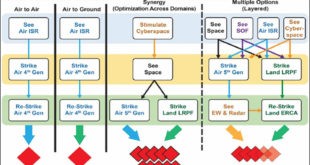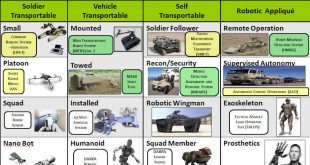There are two approaches to connect Warfighting and emerging technologies. One is to consider the present and future threat environment and then through system analysis we can identify technologies required to mitigate those threats. Secondly, we can identify the emerging technologies that can offer new military capability. Coming to …
Read More »TimeLine Layout
March, 2021
-
10 March
Efficient Piezoelectric technologies for aerospace and defense smart sensors, smart skin, smart combat suits, and energy harvesting
Advanced sensors and actuators, together with exponential improvements in computer technology, are causing a surge of interest in the development of “intelligent” structures and equipment. A smart structure consists of four key elements: actuators, sensors, control strategies, and power conditioning electronics. Numerous applications include automotive springs, smart skins on aircraft, smart …
Read More » -
10 March
Antigravity Technology and Military’s anti-gravity research programmes including Disclosure Project
In Newton’s law of universal gravitation, gravity was an external force transmitted by unknown means. In the 20th century, Newton’s model was replaced by general relativity where gravity is not a force but the result of the geometry of spacetime. Under general relativity, gravity is the result of following spatial geometry …
Read More » -
9 March
US Army’s Robotic and Autonomous Systems (RAS) Strategy for gaining for gaining overmatch in future high-intensity conflicts
As both artificial intelligence and autonomous systems advance at an astonishing rate, scientists and military leaders alike are working through the complexities to determine the best ways of implementing them on the modern battlefield. The accelerating arms race in Artificial Intelligence and the diffusion of cheap, technologically advanced military systems among …
Read More » -
8 March
Militaries require next generation ESM /ELINT systems to counter sophisticated LPI, agile, Ultrawideband, VHF long-range early warning Radar threats
Electronic Warfare EW, encompasses, in all battle phases, military actions involving the use of EM energy to determine, exploit, reduce or prevent hostile use of EM spectrum and the actions, which retain friendly use of the EM spectrum. EW consists of three related sectors, viz., Electronic Protection (EP), Electronic Attack …
Read More » -
8 March
Ships require Attitude Stabilization System for Satellite Tracking Antenna
In the age of information technology, mobile data communication has become essential due to its convenience. A major role of mobile communication networks is to provide ubiquitous broadband services. Regardless of the actual position of the antenna on earth, it is always possible to make contact with a communication satellite. …
Read More » -
6 March
DARPA’s DREaM developing new RF/mm-wave transistors to enable future Military 5G communications, surveillance, signal intelligence (SIGINT), electronic warfare (EW), and electronic countermeasures (ECM)
DARPA has long recognized the critical role transistors play in Department of Defense (DoD) systems – especially radio frequency (RF) systems ranging from radar and communications to signals intelligence and electronic warfare. In the 1990s, the DARPA MIMIC program advanced Gallium Arsenide (GaAs) transistor technology that enabled the radar and …
Read More » -
6 March
Laser stabalization and tracking technologies for moving platform mounted Directed Energy Weapons (DEWs)
The drones have emerged as a major new threat to civilian infrastructure and military. Counter-drone technology, also known as counter-UAS, C-UAS, or counter-UAV technology, refers to systems that are used to detect and/or intercept unmanned aircraft. One of the attractive Anti-drone weapons have been directed energy weapons (DEWs) both of …
Read More » -
6 March
Remerging threat of Biological Weapons attack against Agricultural Targets and Agrobioterrorism, with advances in Gene editing, synthetic biology, and improved delivery systems
Food and agriculture are key elements of the critical infrastructure of every country because they provide products that are essential for life. The United States is a country with a highly developed agricultural sector. Food and agriculture constitute a sixth of the U.S. gross domestic product, totaling more than a …
Read More » -
6 March
UK thrust on Quantum sensors including Quantum accelerometer for future accurate Navigation of submarines and missiles
Sensor technology vital for UK critical national infrastructure is becoming outdated, warn experts at the University of Birmingham-led UK Quantum Technology Hub Sensors and Timing. The current weakness threatens anticipated advances, many involving quantum technologies, across different sectors – including climate change, defence, transportation, energy supplies and healthcare. The warning …
Read More »
 International Defense Security & Technology Your trusted Source for News, Research and Analysis
International Defense Security & Technology Your trusted Source for News, Research and Analysis








